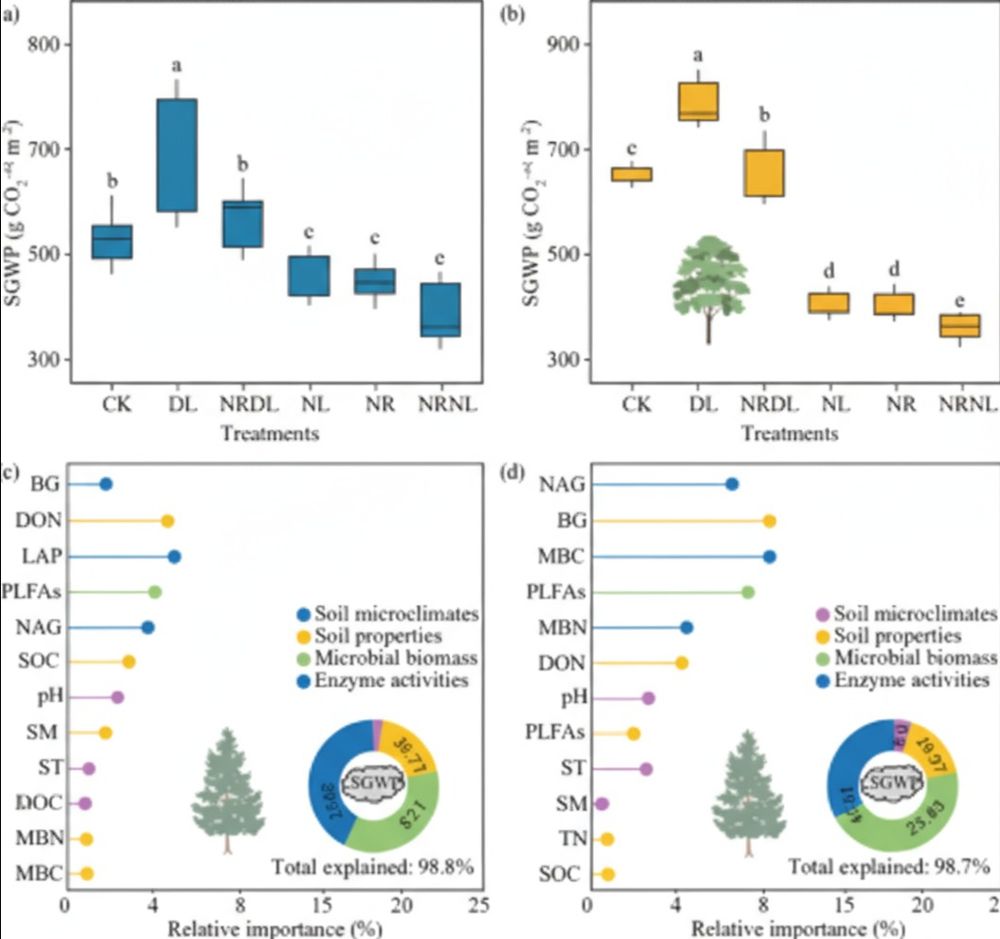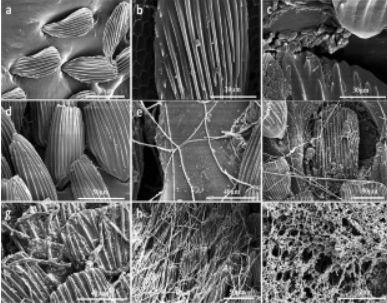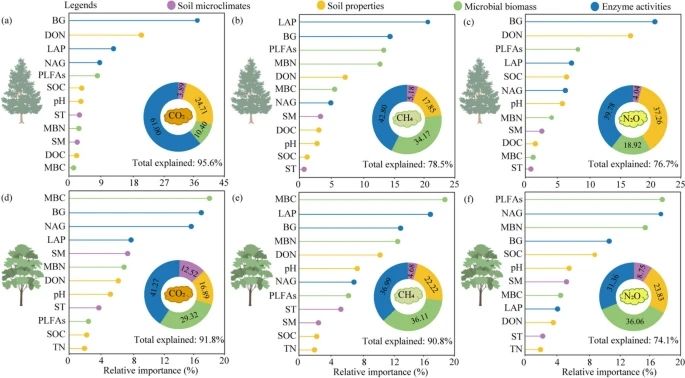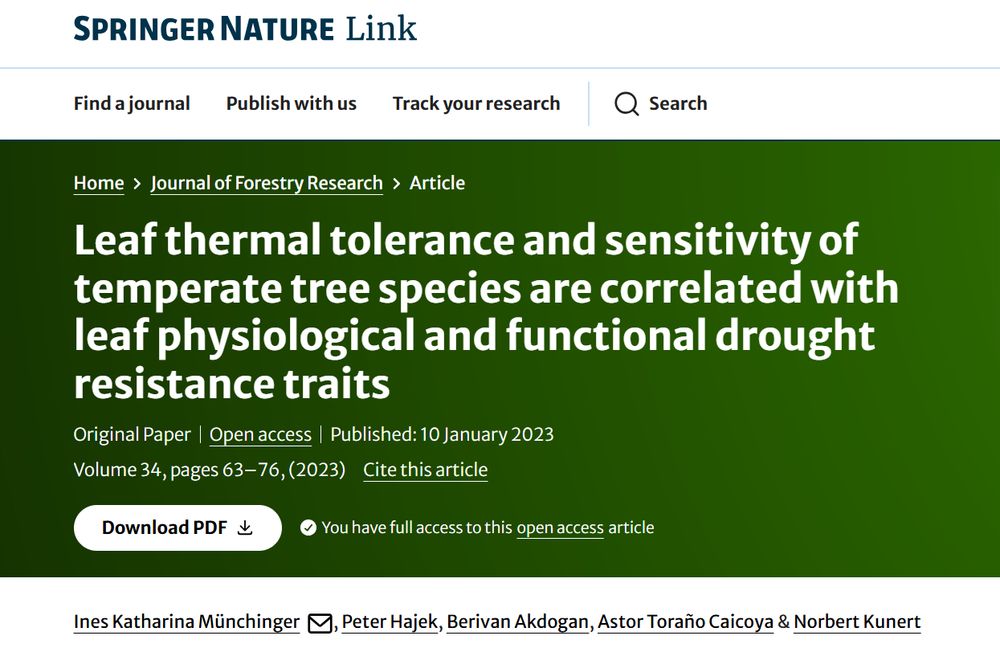
High-density genetic mapping enhances genomic selection accuracy for complex traits in Populus - Journal of Forestry Research
Populus species, important economic species combining rapid growth with broad ecological adaptability, play a critical role in sustainable forestry and bioenergy production. In this study, we performed whole-genome resequencing of 707 individuals from a full-sib family to develop comprehensive single nucleotide polymorphism (SNP) markers and constructed a high-density genetic linkage map of 19 linkage groups. The total genetic length of the map reached 3623.65 cM with an average marker interval of 0.34 cM. By integrating multidimensional phenotypic data, 89 quantitative trait loci (QTL) associated with growth, wood physical and chemical properties, disease resistance, and leaf morphology traits were identified, with logarithm of odds (LOD) scores ranging from 3.13 to 21.72 and phenotypic variance explained between 1.7 and 11.6%. Notably, pleiotropic analysis revealed significant colocalization hotspots on chromosomes LG1, LG5, LG6, LG8, and LG14, with epistatic interaction network analysis confirming genetic basis of coordinated regulation across multiple traits. Functional annotation of 207 candidate genes showed that R2R3-MYB and bHLH transcription factors and pyruvate kinase-encoding genes were significantly enriched, suggesting crucial roles in lignin biosynthesis and carbon metabolic pathways. Allelic effect analysis indicated that the frequency of favorable alleles associated with target traits ranged from 0.20 to 0.55. Incorporation of QTL-derived favorable alleles as random effects into Bayesian-based genomic selection models led to an increase in prediction accuracy ranging from 1 to 21%, with Bayesian ridge regression as the best predictive model. This study provides valuable genomic resources and genetic insights for deciphering complex trait architecture and advancing molecular breeding in poplar.
High-density genetic mapping enhances genomic selection accuracy for complex traits in Populus | Journal of Forestry Research link.springer.com/article/10.1...
@forestryjfr.bsky.social
09.10.2025 13:05 — 👍 1 🔁 1 💬 0 📌 0

How precise is precise enough? Tree crown segmentation using high resolution close-up multispectral UAV images and its effect on NDVI accuracy in Fraxinus excelsior L. trees - Journal of Forestry Research
Detailed individual tree crown segmentation is highly relevant for the detection and monitoring of Fraxinus excelsior L. trees affected by ash dieback, a major threat to common ash populations across Europe. In this study, both fine and coarse crown segmentation methods were applied to close-range multispectral UAV imagery. The fine tree crown segmentation method utilized a novel unsupervised machine learning approach based on a blended NIR–NDVI image, whereas the coarse segmentation relied on the segment anything model (SAM). Both methods successfully delineated tree crown outlines, however, only the fine segmentation accurately captured internal canopy gaps. Despite these structural differences, mean NDVI values calculated per tree crown revealed no significant differences between the two approaches, indicating that coarse segmentation is sufficient for mean vegetation index assessments. Nevertheless, the fine segmentation revealed increased heterogeneity in NDVI values in more severely damaged trees, underscoring its value for detailed structural and health analyses. Furthermore, the fine segmentation workflow proved transferable to both individual UAV images and orthophotos from broader UAV surveys. For applications focused on structural integrity and spatial variation in canopy health, the fine segmentation approach is recommended.
How precise is precise enough? Tree crown segmentation using high resolution close-up multispectral UAV images and its effect on NDVI accuracy in Fraxinus excelsior L. trees | Journal of Forestry Research link.springer.com/article/10.1...
@forestryjfr.bsky.social
09.10.2025 12:56 — 👍 2 🔁 1 💬 0 📌 0

🌍 Forest floors are climate regulators!
A new JFR study tests how roots & litter inputs shape soil CO₂, CH₄, and N₂O fluxes in subalpine forests. Results reveal divergent roles in warming potential & carbon cycling.
🔗 link.springer.com/article/10.1...
#JFR #ForestryResearch #ClimateChange
🧪🌏🌐🍁🌺🌱🌿🦤
08.10.2025 11:52 — 👍 8 🔁 3 💬 1 📌 0
Seeing forests like never before! 🌲 #LiDAR reveals the impact of land use & climate. Thank you @ausjbotany.bsky.social for sharing this study by Patrick Norman.
#JFR #Forestryresearch #OpenAccess
03.10.2025 14:02 — 👍 3 🔁 1 💬 0 📌 0
🐾🌳 This #WorldAnimalDay, remember: forests shelter 80% of terrestrial species. Protecting wildlife means protecting their habitats.
Support global animal welfare: www.worldanimalprotection.org/our-campaign...
#JFR #ForestryResearch #animals #Forestecology
04.10.2025 06:43 — 👍 2 🔁 1 💬 1 📌 0

🏙️🌳 This #WorldHabitatDay, urban forests are our cities' unsung heroes. They're not just beautiful, they're also essential in mitigating the impact of global warming on our urban communities. 🌍
#JFR #UrbanForestry #ClimateResilience #Forestryresearch #Sustainabilty #Resources
🍁🌺🌱🌿🦤
06.10.2025 10:00 — 👍 2 🔁 1 💬 1 📌 0
How do forests nurture more diverse #moth communities than grasslands? 🦋
@bexplo.bsky.social & @animalecology.bsky.social dive deep into the roles of habitat, land-use & temperature. 🌳
A rich read for forest ecologists and biodiversity lovers alike!
#Ecology #ForestryResearch #JFR
06.10.2025 15:11 — 👍 3 🔁 1 💬 0 📌 0
🌳 Fascinating work in @globalchangebio! 🌿 Trees have so many ways of thriving, and diverse strategies across species prove to boost ecosystem productivity.
Thanks to @mixedforests.bsky.social for pushing #TreeDiversity research forward!
#ForestryResearch #JFR #Biodiversity #Sustainability
🌏🌐🍁🌺🌱🌿🦤
29.09.2025 15:02 — 👍 5 🔁 2 💬 0 📌 0
Calling all forestry professionals and climate advocates! What's your take on the most promising area in tree breeding for #climate resilience?
Vote and let's see where the community stands!
#JFR #Forestryresearch
1.🌱Drought Tolerance
2.☀️Heat Resistance
3.💧Water Efficiency
4.🍃Carbon Absorption
30.09.2025 10:42 — 👍 2 🔁 2 💬 0 📌 0

🪲 Boosting biocontrol against wood-boring pests!
Oil-based Beauveria bassiana boosts mortality and infection in Cryptorhynchus lapathi, helping protect poplar and willow.
🔗 link.springer.com/article/10.1...
#JFR #ForestryResearch #Biocontrol #PestManagement #Insect
01.10.2025 08:36 — 👍 2 🔁 1 💬 1 📌 0

Yesterday, the conservation community bid a sad goodbye to the iconic Dame Jane Goodall. 💚🐒
Goodall's pioneering work with primates and their habitats has inspired generations of researchers, and we honor her extraordinary contributions to environmental conservation.
🦤🌎🍁
#ThankYouJane
02.10.2025 10:41 — 👍 4 🔁 3 💬 1 📌 0

Prediction and driving factors of forest fire occurrence in Jilin Province, China - Journal of Forestry Research
Forest fires are natural disasters that can occur suddenly and can be very damaging, burning thousands of square kilometers. Prevention is better than suppression and prediction models of forest fire occurrence have developed from the logistic regression model, the geographical weighted logistic regression model, the Lasso regression model, the random forest model, and the support vector machine model based on historical forest fire data from 2000 to 2019 in Jilin Province. The models, along with a distribution map are presented in this paper to provide a theoretical basis for forest fire management in this area. Existing studies show that the prediction accuracies of the two machine learning models are higher than those of the three generalized linear regression models. The accuracies of the random forest model, the support vector machine model, geographical weighted logistic regression model, the Lasso regression model, and logistic model were 88.7%, 87.7%, 86.0%, 85.0% and 84.6%, respectively. Weather is the main factor affecting forest fires, while the impacts of topography factors, human and social-economic factors on fire occurrence were similar.
Prediction and driving factors of forest fire occurrence in Jilin Province, China | Journal of Forestry Research link.springer.com/article/10.1...
01.10.2025 04:52 — 👍 0 🔁 0 💬 0 📌 0


Climate-smart forestry: an AI-enabled sustainable forest management solution for climate change adaptation and mitigation | Journal of Forestry Research
link.springer.com/article/10.1...
#Forest #Climate #SmartForestry
@forestryjfr.bsky.social @royalforestrysoc.bsky.social
01.10.2025 04:46 — 👍 3 🔁 1 💬 0 📌 0

Understory plant diversity and phenolic allelochemicals across a range of #Eucalyptus grandis plantation ages | Journal of Forestry Research link.springer.com/article/10.1...
@forestryjfr.bsky.social
01.10.2025 04:12 — 👍 3 🔁 0 💬 0 📌 0

Modelling vehicles as vectors of forest pest and pathogen spread - Journal of Forestry Research
Invasive pests and pathogens cause immense damage globally, costing an estimated US$ 248 billion to the agricultural industry alone. Vehicles, such as farming and timber harvesting machinery and transportation trucks, can facilitate the rapid spread of biological invaders over distances far greater and more quickly than their natural dispersal ability. Understanding how frequent trips by these vehicles increase the spread of invasive agricultural and forestry pests can help inform effective biosecurity procedures before, during, or after an incursion. We used a case study of timber transport trucks in Aotearoa New Zealand to examine whether and how vehicles facilitate the spread of soil-borne pathogens between commercial forest plantations. Our results show that long-distance dispersal associated with truck movement facilitated the introduction of oomycete-like pathogens in 97% of forest sites within only one year, with pathogen loads within infected sites predicted at 84% of the sites’ carrying capacity. Implementing preventative management strategies to reduce the transportation of infected soil by logging trucks, however, can reduce the spread by up to 50% after one year and reduce the pathogen load within infested sites by more than three times. Mitigating other human-assisted dispersal pathways can also help reduce spread. Reducing movement of forest visitors not involved in forestry activities, for instance, by closing forest sites to the public, can help to further reduce spread in addition to management related to harvesting activities. These results highlight the benefits of preventative management strategies in reducing the spread rate of novel soil pathogens through a high-intensity commercial forestry network but show that pest spread is still likely even with significant investment.
Modelling vehicles as vectors of forest pest and pathogen spread | Journal of Forestry Research link.springer.com/article/10.1...
#Pest #Forest #Pathogen #NewZealand
@forestryoup.bsky.social @forestryjournal.bsky.social
rdcu.be/eIYFN
01.10.2025 03:28 — 👍 1 🔁 0 💬 0 📌 0

Effects of climate change on the richness distribution of Phyllostachys species in China - Journal of Forestry Research
Climate change disrupts the distribution of species and restructures their richness patterns. The genus of Asian bamboo, Phyllostachys, possesses significant ecological and economic values, and represents the most species-rich genus in the Bambusoideae subfamily. Based on the distribution data of 46 species and 20 environmental variables, we used the MaxEnt model combined with ArcGIS calculations to simulate current and future potential richness distributions under three distinct CO2 emission scenarios. The results showed that the MaxEnt model had a good predictive ability, with a mean area under the working characteristic curve (AUC value) of 0.91 for all species. The main environmental variables that impacted the future distribution of most Phyllostachys species were elevation, variations of seasonal precipitation, and mean diurnal range. Phyllostachys species are currently concentrated in southeastern China. Under future climate projections, 18 species exhibited significant habitat contraction across three or more future climate scenarios, but suitable habitats for other species will expand. This enhancement is most pronounced under the extreme climate scenario (2090s-SSP585), primarily driven by high species gains contributing to elevated turnover values across scenarios. The center of maximum richness will progressively shift southwestward over time. Predictive modeling of Phyllostachys richness distribution dynamics under climate change enhances our understanding of its biogeography and informs strategic introduction programs to bamboo management and augments China's carbon sequestration capacity.
Effects of climate change on the richness distribution of Phyllostachys species in China | Journal of Forestry Research link.springer.com/article/10.1...
#Climate #Forest #Ecology
29.09.2025 12:54 — 👍 1 🔁 0 💬 0 📌 0

Exploring the boost by dominant ectomycorrhizal trees to soil organic carbon sequestration in the subtropical forest of the Jiulianshan National Nature Reserve - Journal of Forestry Research
Soil organic carbon in forest affects nutrient availability, microbial processes, and organic matter inputs. Dominant tree species have increasingly shifted from ectomycorrhizal to arbuscular mycorrhizal associations in subtropical forests. However, the consequences of this shift for soil organic carbon is poorly understood. To address this, a field study was conducted across a natural gradient of arbuscular tree associations to investigate how different mycorrhizal associations affect soil organic carbon quantity, composition, chemical stability, and related soil properties. Soil organic carbon fractions, functional groups, microbial enzyme activities were analyzed. Results showed that increasing arbuscular mycorrhizal dominance was associated with declines in total soil organic carbon, particularly in recalcitrant and aromatic carbon forms. Ectomycorrhizal-dominated forests exhibited higher nitrogen availability and elevated nitrogen-hydrolyzing enzyme activity, suggesting enhanced nitrogen acquisition strategies that suppress soil organic carbon decomposition and promote carbon retention. These findings indicate that mycorrhizal-mediated shifts in tree composition may significantly alter soil carbon sequestration potential. Incorporating mycorrhizal functional traits into forest management and carbon modeling could improve predictions of soil organic carbon responses under future environmental change. Graphical abstract
Exploring the boost by dominant ectomycorrhizal trees to soil organic carbon sequestration in the subtropical forest of the Jiulianshan National Nature Reserve | Journal of Forestry Research link.springer.com/article/10.1...
#EctomycorrhizalTrees #Soil #Carbon
27.09.2025 00:44 — 👍 3 🔁 0 💬 0 📌 0

Combining different climate datasets better reflects the response of warm-temperate forests to climate: a case study from Mt. Dongling, Beijing - Journal of Forestry Research
Accurately assessing the relationship between tree growth and climatic factors is of great importance in dendrochronology. This study evaluated the consistency between alternative climate datasets (including station and gridded data) and actual climate data (fixed-point observations near the sampling sites), in northeastern China’s warm temperate zone and analyzed differences in their correlations with tree-ring width index. The results were: (1) Gridded temperature data, as well as precipitation and relative humidity data from the Huailai meteorological station, was more consistent with the actual climate data; in contrast, gridded soil moisture content data showed significant discrepancies. (2) Horizontal distance had a greater impact on the representativeness of actual climate conditions than vertical elevation differences. (3) Differences in consistency between alternative and actual climate data also affected their correlations with tree-ring width indices. In some growing season months, correlation coefficients, both in magnitude and sign, differed significantly from those based on actual data. The selection of different alternative climate datasets can lead to biased results in assessing forest responses to climate change, which is detrimental to the management of forest ecosystems in harsh environments. Therefore, the scientific and rational selection of alternative climate data is essential for dendroecological and climatological research.
Combining different climate datasets better reflects the response of warm-temperate forests to climate: a case study from Mt. Dongling, Beijing | Journal of Forestry Research link.springer.com/article/10.1...
#JFR #Climate #Forest
@forestryjfr.bsky.social
25.09.2025 12:31 — 👍 2 🔁 0 💬 0 📌 0

Saturating allometric relationships reveal how wood density shapes global tree architecture - Journal of Forestry Research
Allometric equations are fundamental tools in ecological research and forestry management, widely used for estimating above-ground biomass and production, serving as the core foundations of dynamic vegetation models. Using global datasets from Tallo (a tree allometry and crown architecture database encompassing thousands of species) and TRY (a plant traits database), we fit Bayesian hierarchical models with three alternative functional forms (power-law, generalized Michaelis–Menten (gMM), and Weibull) to characterize how diameter at breast height (DBH), tree height (H), and crown radius (CR) scale with and without wood density as a species-level predictor. Our analysis revealed that the saturating Weibull function best captured the relationship between tree height and DBH in both functional groups, whereas the CR–DBH relationship was best predicted by a power-law function in angiosperms and by the gMM function in gymnosperms. Although including wood density did not significantly improve predictive performance, it revealed important ecological trade-offs: lighter-wood angiosperms achieve taller mature heights more rapidly, and denser wood promotes wider crown expansion across clades. We also found that accurately estimating DBH required considering both height and crown size, highlighting how these variables together distinguish trees of similar height but differing trunk diameters. Our results emphasize the importance of applying saturating functions for large trees to improve forest biomass estimates and show that wood density, though not always predictive at broad scales, helps illuminate the biomechanical and ecological constraints underlying diverse tree architectures. These findings offer practical pathways for integrating height- and crown-based metrics into existing carbon monitoring programs worldwide.
🌳 What controls tree growth patterns worldwide?
Global datasets and Bayesian models reveal how height, trunk size, and crown shape interact to reshape biomass and carbon estimates.
🔗 link.springer.com/article/10.1...
#JFR #ForestryResearch #Sustainability #Environment #Biodiversity
🍁🌺🌱🌿🦤
24.09.2025 06:54 — 👍 2 🔁 1 💬 0 📌 0

Litter input manipulations differentially regulated CO2, CH4 and N2O emissions from subalpine coniferous and broad-leaf forest soils | Journal of Forestry Research link.springer.com/article/10.1...
@forestryjfr.bsky.social
23.09.2025 13:13 — 👍 3 🔁 0 💬 0 📌 0
Thanks @natureportfolio.nature.com for breaking it down! 🌱 Warming speeds up soil respiration in tropical forests.
Future carbon losses may be bigger than we thought.
#SoilScience #ForestryResearch #ClimateAction #JFR #Forestryresearch
22.09.2025 15:00 — 👍 2 🔁 1 💬 0 📌 0

Did you know the 1987 storm wiped out 15M trees in the UK? 🌳This tragedy sparked initiatives like Seed Gathering Season, vital for forest restoration & preserving native species.
🌱Discover its history & impact in this month-long conservation celebration: nationaltoday.com/seed-gatheri...
23.09.2025 07:25 — 👍 2 🔁 1 💬 0 📌 0
🌱This #SeedGatheringSeason, let’s honor the power of tree seeds! Each one fuels research in forest genetics, climate adaptation & biodiversity conservation. Every seed collected contributes to vital research in forest genetics.
#ForestryResearch #JFR #ForestScience
23.09.2025 07:25 — 👍 2 🔁 1 💬 1 📌 0
🌍This #WorldCleanupDay, let's give forests a fresh breath.
🧹Industrial waste pollutes more than water & air, it seeps into our forests, affecting soil & vegetation. New research shows how toxic discharges harm forest health.🌱 link.springer.com/article/10.1...
#ForestryResearch #JFR #Climate
🍁🌺🌱🌿
20.09.2025 06:50 — 👍 5 🔁 1 💬 0 📌 0
🌲This #FSCForestWeek, what’s one step YOU can take for forests? 🌍 Choose FSC products, cut paper waste, or back reforestation, every action matters. Forests are our climate shield & lifeline. 💚
Read more: link.springer.com/journal/11676
#JFR #ForestryResearch #ClimateAction #Biodiversity
🍁🌺🌱🌿🦤
21.09.2025 06:13 — 👍 6 🔁 1 💬 0 📌 0

Accumulation of heavy metal in Platanus orientalis, Robinia pseudoacacia and Fraxinus rotundifolia | Journal of Forestry Research link.springer.com/article/10.1...
20.09.2025 05:45 — 👍 0 🔁 0 💬 0 📌 0

Leaf thermal tolerance and sensitivity of temperate tree species are correlated with leaf physiological and functional drought resistance traits | Journal of Forestry Research link.springer.com/article/10.1...
20.09.2025 05:31 — 👍 1 🔁 0 💬 0 📌 0

JFR Hot Paper: #Drone #remote sensing for #forestry research and practices. By: Prof. Guofan Shao from #PurdueUniversity
| Journal of Forestry Research link.springer.com/article/10.1...
@forestresearchuk.bsky.social @royalforestrysoc.bsky.social
20.09.2025 05:12 — 👍 1 🔁 0 💬 0 📌 0
Join a bleeding-heart liberal and compulsive speculator rambling about saving the world with win-win games at nonzerosum.games!
I contain multitudes, today I am a grandiose yet mild-mannered bedeviled slinker with an organic roguishness
The Earth BioGenome Project (EBP), a moonshot for biology, aims to sequence, catalog, and characterize the genomes of all of Earth's eukaryotic biodiversity over a period of ten years.
🌲Keep up with all EBP updates: https://linktr.ee/earthbiogenomeproject
📸 Photographer | capturing life's candid moments with my camera 📸
🌍 https://rupertrivett.photoshelter.com 🌍
#RealStreetPhotography #Photojournalism|
Skilled in unobtrusive, authentic #storytelling
📣NEW SUBSTACK 📔
👇📸👇📸👇📸👇📸
https://rupephoto.substack.com/
Inpirational quotes and motivation
Backup @wealthymindsets
Help Ali and his family by donating to me and sharing my link please. 🙏🙏
Software quântico raro que publica tarô e que também está conectado em IAs. Na postagem fixada existem dicas de uso. @terraprotege.bsky.social 🌱🌎
My Portfolio: https://portfolio.pixelfed.social/JoeGarrity
𝔸𝔸𝕄𓆃
╔╗╔╗──╔╗────────╔═╗
║║║╠═╦╬╬═╦═╦╦╦═╦╣═╣
║╚╝║║║║║═╣╬║╔╣║║╠═║
╚══╩╩═╩╩═╩═╩╝╚╩═╩═╝ ╔═╗─╔╦═╦╗─
║╦╬╦╬╣═╣╚╗
║╩╬║╣╠═║╔╣
╚═╩╩╩╩═╩═╝
✰✰✰✰✰✰✰✰✰✰✰✰✰✰✰✰✰✰✰
✧✧𝟛𝟙.𝟙𝟚.𝟙𝟡𝟡𝟜✧✧➪✧✧𝕄𝕪 𝕓𝕚𝕣𝕥𝕙𝕕𝕒𝕪✧✧
✧✧✧✧✧✧✧✧✧✧✧✧✧✧✧✧✧✧✧✧
✧✧𝕃𝕠𝕔𝕒𝕥𝕚𝕠𝕟✧✧➬✧✧𝕆ℕ 𝕋ℍ𝔼 𝕎𝔸𝕐 𝕋𝕆 𝕀𝕄𝕄𝕆ℝ𝕋𝔸𝕃𝕀𝕋𝕐✧✧
✰✰✰✰✰✰✰✰✰✰✰
I'm an effective altruist mainly reading and boosting posts, but occasionally I'll muse and doodle about effective altruism. I take a balanced approach, so will highlight under-represented views—my opinions will no doubt become apparent :)
Associate Researcher at the LBGE of Marien Ngouabi University. I specialize in the study of the ecology and sustainable management of tropical forests.
Ecosystem ecologist and remote sensing enthusiast.
Plant ecologist at #XTBG interested in Community Ecology, Data Science.
https://mattocci27.github.io/
Spammers get blocked. | Gothic gardener. 🇨🇦. Goth, goblincore, dark art, horror, Halloween, poisonous plants. Nyctophile. Autistic murder hornet. Genderqueer. Pan. They/them. 🌿🍁🍂🎃
An open access journal covering forest ecosystems, forest communities, forest environment, remote sensing, climate change, big data (2024JIF=4.4)
https://www.sciencedirect.com/journal/forest-ecosystems
Tropical forest ecologist | Professor | Wageningen University 🇳🇱 | Climate change impacts on trees & forests | Tropical 🌳 rings | Dendrochronology | Timber tracing | Model-data integration
Your gateway to jobs that protect the planet. 🌍
Explore careers in climate, renewable energy, clean tech, sustainability & more. 🌱
🔎 Search now: https://greenercareers.co.uk
Curious about trees, water, ecophysiology, stable isotopes, species interactions, dataviz & fieldwork food. PhD candidate at Göttingen University DE, part of @enricounigoe.bsky.social and @foreslab.bsky.social
News - Magazine - Blog
Your go-to source for fresh perspectives, trending stories, and thoughtful insights. Curated content across news, culture, and ideas, daily updates that inform, inspire, and spark conversation.
beyondlink.live






















